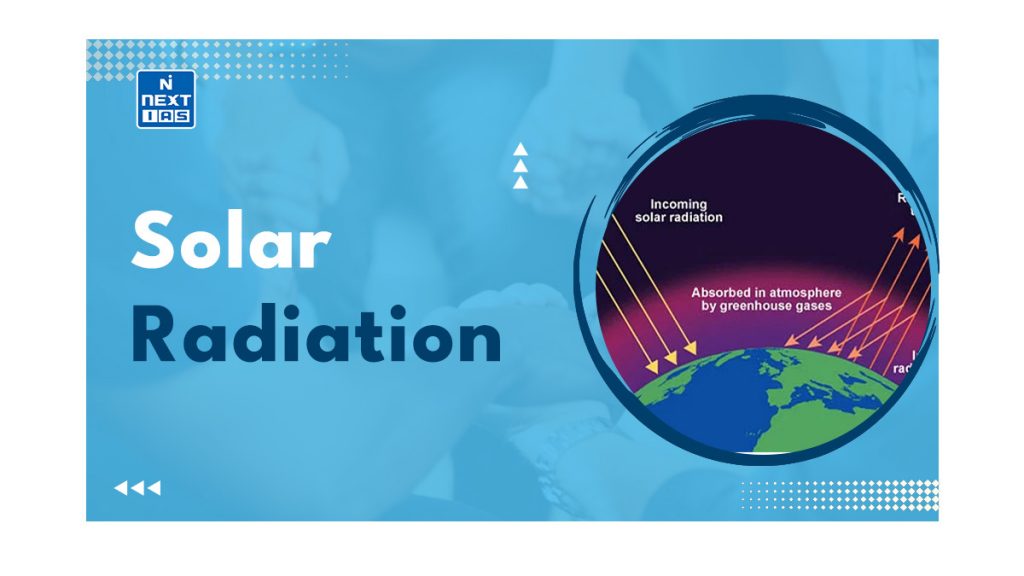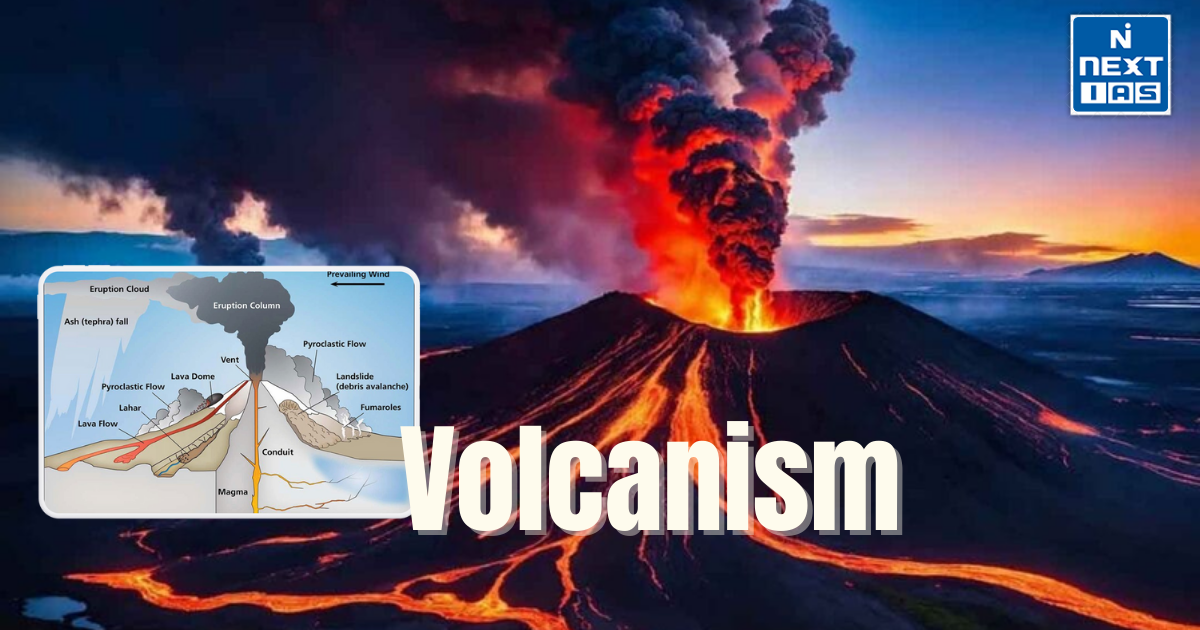
What is Solar Radiation?
- The earth’s surface primarily receives its energy in the form of short wavelengths. This energy, known as incoming solar radiation or insolation, is absorbed by the earth.
- Due to the Earth’s spherical shape, the sun’s rays hit the top of the atmosphere at an angle, resulting in only a small portion of the sun’s energy being intercepted by the Earth.
On average, the earth receives 1.94 calories per square cm per minute at the top of its atmosphere.
Variability of Insolation at the Surface of the Earth
- The amount and intensity of sunlight received fluctuate throughout the day, season, and year. Several factors contribute to these variations in sunlight, including the rotation of the Earth on its axis, the angle at which the sun’s rays hit the Earth’s surface, the duration of daylight, the transparency of the atmosphere, and the way the land is positioned.
- The amount of insolation received is influenced by two factors, one of which is the angle at which the sun’s rays hit the Earth’s surface.
- This angle is determined by the latitude of a place. As the latitude increases, the angle between the rays and the surface decreases, causing the rays to become slanted.
- The area covered by vertical rays is always smaller than that covered by slanted rays. When a larger area is covered, the energy is spread out, leading to a decrease in the net energy received per unit area.
- Additionally, slanted rays have to pass through a greater depth of the atmosphere, resulting in more absorption, scattering, and diffusion.
The Passage of the Solar Radiation through the Atmosphere
- The atmosphere allows shortwave solar radiation to pass through it, making it mostly transparent. This solar radiation travels through the atmosphere and reaches the surface of the Earth.
- However, certain gases like water vapour and ozone, present in the troposphere, absorb a significant amount of near-infrared radiation.
- Additionally, tiny particles suspended in the troposphere scatter visible light in both directions: toward space and towards the Earth’s surface.
- This scattering process is responsible for the coloration of the sky. The red hues observed during sunrise and sunset, as well as the blue color of the sky, are the outcomes of light scattering within the atmosphere.
Spatial Distribution of Insolation on the Earth’s Surface
- The amount of sunlight received on the Earth’s surface differs depending on the location.
- In tropical regions, the surface receives approximately 320 Watt/m2 of sunlight, while in the polar regions, it is about 70 Watt/m2.
- The subtropical deserts experience the highest amount of sunlight due to lower cloud coverage.
- The equator receives less sunlight compared to the tropics. Generally, land areas receive more sunlight than ocean areas at the same latitude.
- During winter, middle and higher latitudes receive less sunlight compared to summer.
Terrestrial Solar Radiation
- The Earth receives sunlight in the form of short waves, which heats up its surface. As a result, the Earth becomes a radiating body and emits energy to the atmosphere as long waves. This energy warms up the atmosphere from below, a process referred to as terrestrial radiation.
- The atmospheric gasses, especially carbon dioxide and other greenhouse gasses, absorb this long wave radiation.
Heat Budget of the Earth
- A heat budget is a perfect balance between incoming heat (insolation) absorbed by the earth and outgoing heat (terrestrial radiation) escaping it in the form of radiation.
- If the incoming heat and the outgoing heat are not balanced, then Earth would be getting either too warmer or cooler. Since these are perfectly balanced the earth is neither too warm nor too cold.
- The equilibrium that exists between the insolation (short waves) and the terrestrial radiation (long waves) is called the heat budget of the earth.
Source: NCERT
Brief Explanation of Heat Budget
- The Earth maintains its temperature by balancing the amount of heat it receives and loses. This equilibrium occurs when the heat received from the Sun, known as insolation, is equal to the heat lost through terrestrial radiation.
- To illustrate, let’s consider that the top of the atmosphere receives 100% of the insolation. However, as it passes through the atmosphere, some of the energy is reflected, scattered, and absorbed. Only a portion of the insolation reaches the Earth’s surface.
- Approximately 35 units of insolation are reflected back into space before even reaching the Earth’s surface. Out of these, 27 units are reflected from the top of clouds, and 2 units are reflected from snow and ice-covered areas. The reflected radiation is referred to as the Earth’s albedo.
- The remaining 65 units of insolation are absorbed, with 14 units absorbed within the atmosphere and 51 units absorbed by the Earth’s surface. The Earth then radiates back 51 units of terrestrial radiation.
- Out of these, 17 units are radiated directly into space, while the remaining 34 units are absorbed by the atmosphere.
- Additionally, 48 units absorbed by the atmosphere are also radiated back into space. Therefore, the total radiation returning from the Earth and the atmosphere is 17 + 48 = 65 units, which balances the total of 65 units received from the Sun.
- This balance between incoming and outgoing radiation is known as the Earth’s heat budget or heat balance.
Temperature
- The insolation’s interaction with the atmosphere and the earth’s surface generates heat, which is quantified as temperature. Heat signifies the molecular motion of particles within a substance, while temperature is the numerical measurement of how hot or cold something is, and expressed in degrees.
Temperature Inversion
- Temperature inversion, also called thermal inversion, refer to a reversal of the normal behaviour of temperature in the troposphere (the closest region of the atmosphere of Earth’s surface), in which a layer of cool air at the surface is superimposed by a layer of warmer air. (Thus, under normal conditions air temperature usually decreases with height.)
- In hills and mountains, a phenomenon called inversion occurs as a result of air drainage. During the night, cold air is generated in these areas and is pulled downward by gravity.
- Because cold air is heavy and dense, it behaves similar to water and flows down the slopes, accumulating in pockets and valleys while warmer air remains above. This process is known as air drainage and serves as a protective measure for plants, preventing them from being harmed by frost.
To sum up it can be said that the solar radiation, Heat budget of the earth with the temperature distribution plays a significant role in variation in the earth’s atmosphere and weather conditions.
Source: Earth.com
GS - 1





